-
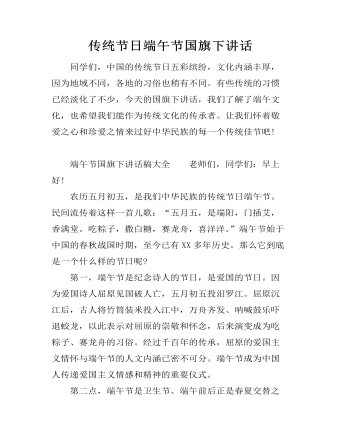
传统节日端午节国旗下讲话
同学们,中国的传统节日五彩缤纷,文化内涵丰厚,因为地域不同,各地的习俗也稍有不同。有些传统的习惯已经淡化了不少,今天的国旗下讲话,我们了解了端午文化,也希望我们能作为传统文化的传承者。让我们怀着敬爱之心和珍爱之情来过好中华民族的每一个传统佳节吧!端午节国旗下讲话稿大全 老师们,同学们:早上好!农历五月初五,是我们中华民族的传统节日端午节。民间流传着这样一首儿歌:“五月五,是端阳,门插艾,香满堂。吃粽子,撒白糖,赛龙舟,喜洋洋。”端午节始于中国的春秋战国时期,至今已有XX多年历史。那么它到底是一个什么样的节日呢?第一,端午节是纪念诗人的节日,是爱国的节日。因为爱国诗人屈原见国破人亡,五月初五投汨罗江。屈原沉江后,古人将竹筒装米投入江中,万舟齐发、呐喊鼓乐吓退蛟龙,以此表示对屈原的崇敬和怀念,后来演变成为吃粽子、赛龙舟的习俗。经过千百年的传承,屈原的爱国主义情怀与端午节的人文内涵已密不可分。端午节成为中国人传递爱国主义情感和精神的重要仪式。第二点,端午节是卫生节。端午前后正是春夏交替之时,天气炎热,多雨潮湿,蚊虫滋生,病虫害渐多,是传染病的高发时节。为了避免疾病的发生,古人在端午节前后插艾叶用以驱蚊蝇、虫蚁,净化空气。 端午这一天,成年人还要饮雄黄酒驱蛇虫,小孩子要佩戴藏有朱砂、雄黄、香草的香囊预防疾病。 这些习俗表达的是古人驱瘟避邪、祈福佑安的愿望。这样来看,端午节是中国最早的“卫生防疫节”。
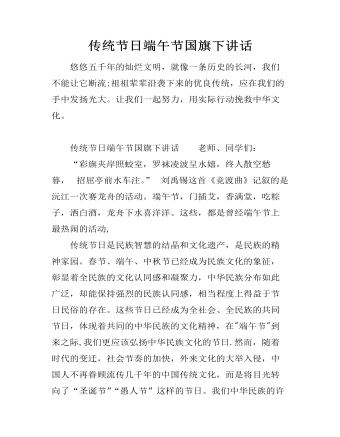
传统节日端午节国旗下讲话
悠悠五千年的灿烂文明,就像一条历史的长河,我们不能让它断流;祖祖辈辈沿袭下来的优良传统,应在我们的手中发扬光大。让我们一起努力,用实际行动挽救中华文化。传统节日端午节国旗下讲话 老师、同学们:“彩旗夹岸照蛟室,罗袜凌波呈水嬉,终人散空愁暮, 招屈亭前水车注。” 刘禹锡这首《竞渡曲》记叙的是沅江一次赛龙舟的活动。端午节,门插艾,香满堂,吃粽子,洒白酒,龙舟下水喜洋洋。这些,都是曾经端午节上最热闹的活动,传统节日是民族智慧的结晶和文化遗产,是民族的精神家园。春节、端午、中秋节已经成为民族文化的象征,彰显着全民族的文化认同感和凝聚力,中华民族分布如此广泛,却能保持强烈的民族认同感,相当程度上得益于节日民俗的存在。这些节日已经成为全社会、全民族的共同节日,体现着共同的中华民族的文化精神,在"端午节"到来之际,我们更应该弘扬中华民族文化的节日.然而,随着时代的变迁,社会节奏的加快,外来文化的大举入侵,中国人不再眷顾流传几千年的中国传统文化,而是将目光转向了“圣诞节”“愚人节”这样的节日。我们中华民族的许多优秀文化传统在漫漫的消失或降低,我们的教育不仅要关注学生的语文,数学,英语等科目的学习,也要关注古老深厚的传统文化。现在,许多旅居在海外的华人、华侨历经几十年甚至更长久的国外生活,但是依然保持着我们的传统,他们虽然身在国外,依旧过春节、清明节、端午节、中秋节和重阳节等我们的民族节日.然而,现在我们国内的学生却喜欢吃的是麦当劳、肯德基、巧克力;看的是日本的动画片及韩国电视剧,过的是圣诞节等西方节日……我们的民族节日却不能引起他们的关注,这不得不引起我们的思索。
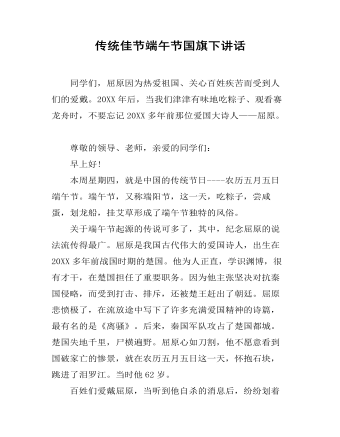
传统佳节端午节国旗下讲话
同学们,屈原因为热爱祖国、关心百姓疾苦而受到人们的爱戴。20XX年后,当我们津津有味地吃粽子、观看赛龙舟时,不要忘记20XX多年前那位爱国大诗人——屈原。尊敬的领导、老师,亲爱的同学们:早上好!本周星期四,就是中国的传统节日----农历五月五日端午节。端午节,又称端阳节,这一天,吃粽子,尝咸蛋,划龙船,挂艾草形成了端午节独特的风俗。关于端午节起源的传说可多了,其中,纪念屈原的说法流传得最广。屈原是我国古代伟大的爱国诗人,出生在20XX多年前战国时期的楚国。他为人正直,学识渊博,很有才干,在楚国担任了重要职务。因为他主张坚决对抗秦国侵略,而受到打击、排斥,还被楚王赶出了朝廷。屈原悲愤极了,在流放途中写下了许多充满爱国精神的诗篇,最有名的是《离骚》。后来,秦国军队攻占了楚国都城。楚国失地千里,尸横遍野。屈原心如刀割,他不愿意看到国破家亡的惨景,就在农历五月五日这一天,怀抱石块,跳进了泪罗江。当时他62岁。
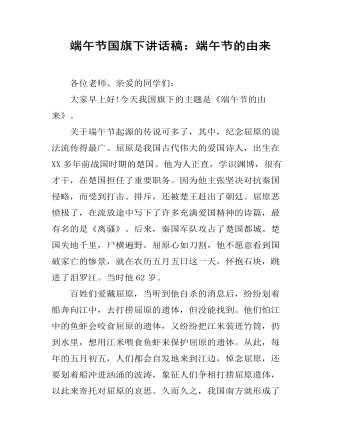
端午节国旗下讲话稿:端午节的由来
各位老师、亲爱的同学们:大家早上好!今天我国旗下的主题是《端午节的由来》。关于端午节起源的传说可多了,其中,纪念屈原的说法流传得最广。屈原是我国古代伟大的爱国诗人,出生在XX多年前战国时期的楚国。他为人正直,学识渊博,很有才干,在楚国担任了重要职务。因为他主张坚决对抗秦国侵略,而受到打击、排斥,还被楚王赶出了朝廷。屈原悲愤极了,在流放途中写下了许多充满爱国精神的诗篇,最有名的是《离骚》。后来,秦国军队攻占了楚国都城。楚国失地千里,尸横遍野。屈原心如刀割,他不愿意看到国破家亡的惨景,就在农历五月五日这一天,怀抱石块,跳进了泪罗江。当时他62岁。百姓们爱戴屈原,当听到他自杀的消息后,纷纷划着船奔向江中,去打捞屈原的遗体,但没能找到。他们怕江中的鱼虾会咬食屈原的遗体,又纷纷把江米装迸竹筒,扔到水里,想用江米喂食鱼虾来保护屈原的遗体。
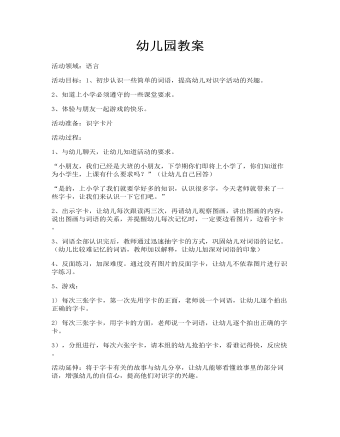
幼儿园教案
1、与幼儿聊天,让幼儿知道活动的要求。“小朋友,我们已经是大班的小朋友,下学期你们即将上小学了,你们知道作为小学生,上课有什么要求吗?”(让幼儿自己回答)“是的,上小学了我们就要学好多的知识,认识很多字,今天老师就带来了一些字卡,让我们来认识一下它们吧。”2、出示字卡,让幼儿每次跟读两三次,再请幼儿观察图画,讲出图画的内容,说出图画与词语的关系,并提醒幼儿每次记忆时,一定要边看图片,边看字卡。3、词语全部认识完后,教师通过迅速抽字卡的方式,巩固幼儿对词语的记忆。(幼儿比较难记忆的词语,教师加以解释,让幼儿加深对词语的印象)4、反面练习,加深难度。通过没有图片的反面字卡,让幼儿不依靠图片进行识字练习。
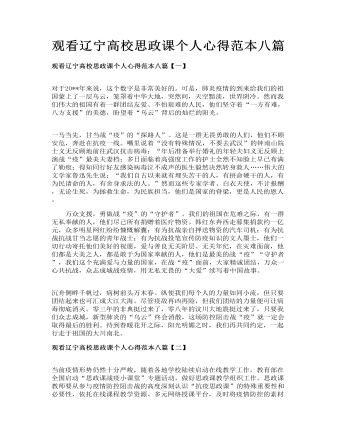
观看辽宁高校思政课个人心得范本八篇
万众支援,勇做战“疫”的“守护者”。我们的祖国在危难之际,有一群无私奉献的人,他们尽己所有捐赠着医疗物资。韩红东奔西走募集捐款约一亿元,众多明星网红纷纷慷慨解囊;有为抗战亲自押送物资的汽车司机;有为抗战抗战甘当志愿的青年战士;有为抗战投笔宣传防疫知识的文人墨士,他们一切行动寄托他们美好的祝愿,爱与善良无关阶层、无关年纪,在灾难面前,他们都是大美之人,都是敢于为国家奉献的人,他们是最美的战“疫”“守护者”,我们这个充满爱与力量的国家,在战“疫”面前,大家精诚团结,万众一心共抗战,众志成城战疫情,用无私无畏的“大爱”续写着中国故事。
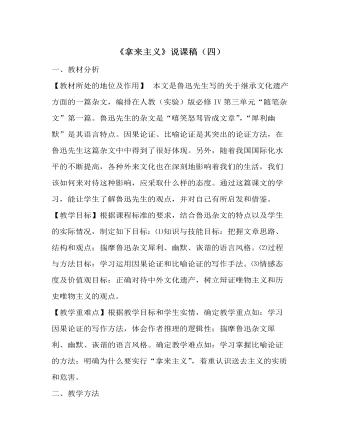
《拿来主义》说课稿(四) 统编版高中语文必修上册
【教学目标】根据课程标准的要求,结合鲁迅杂文的特点以及学生的实际情况,制定如下目标:⑴知识与技能目标:把握文章思路、结构和观点;揣摩鲁迅杂文犀利、幽默、诙谐的语言风格。⑵过程与方法目标:学习运用因果论证和比喻论证的写作手法。⑶情感态度及价值观目标:正确对待中外文化遗产,树立辩证唯物主义和历史唯物主义的观点。【教学重难点】根据教学目标和学生实情,确定教学重点如:学习因果论证的写作方法,体会作者推理的逻辑性;揣摩鲁迅杂文犀利、幽默、诙谐的语言风格。确定教学难点如:学习掌握比喻论证的方法;明确为什么要实行“拿来主义”,着重认识送去主义的实质和危害。二、教学方法教学应坚持“以学生为主体”的原则,尽可能发挥学生学习的能动性和主动性,培养学生独立思考的能力,调动学生学习积极性,因此本文采用“疑问教学法”相对合适。
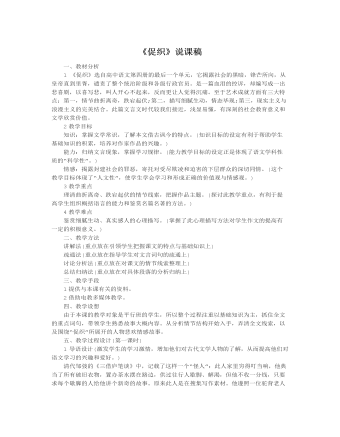
《促织》说课稿2020-2021学年统编版高中语文必修下册
蒲松龄(1640——1715)字留仙,一字剑臣,号柳泉居士。山东淄川(今淄博)人。清代小说家,出身于没落地主家庭。天资聪明,学问深厚,十九岁时连中县、府、道三个第一,但此后屡应省试不第,年七十一,始被补上岁贡生,一生忧郁自伤,穷愁潦倒。从二十岁左右开始写作,历时二十余年,创作了文言短篇小说集《聊斋志异》。另有诗、文集《聊斋诗集》、《聊斋文集》。《聊斋志异》是蒲松龄倾力创作的文言短篇小说集。“聊斋”是作者的书斋名。“志异”就是记述花妖狐鬼及其他一些荒诞不经的奇闻轶事。作者巧妙地通过这些离经虚幻的故事,大胆地揭露社会多方面的黑暗现实,赞美了青年男女敢于冲破封建礼教樊篱的精神,抒发了作者自己满腔的“孤愤”。郭沫若曾题蒲松龄故居联:“写鬼写妖,高人一等;刺贪刺虐,入木三分。”老舍题联:“鬼狐有性格,笑骂成文章。”简明而生动地道出了《聊斋志异》的文学特点。
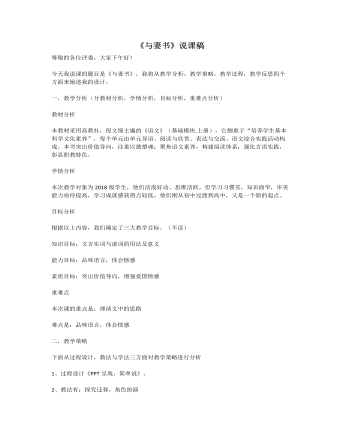
《与妻书》说课稿2020—2021学年统编版高中语文下册
二,教学策略下面从过程设计,教法与学法三方面对教学策略进行分析1、过程设计《PPT呈现,简单说》。2、教法有:探究迁移,角色扮演3、学法有:小组讨论,自主学习,三,教学过程本次课前预习,课中学习,课后练习三个环节。(一)课前准备课前准备环节分前置性学习和课前诊断。前置性学习可通过微课,教材等课程资源,对相关知识进行自学,了解背景,疏通文义,实行小检测。(二)课中学习课中学习环节分自主学习,合作探究,拓展延伸三个步骤。步骤一,自主学习文言实词与虚词的用法及意义,总结规律。步骤二,围绕题目展开,理清文中思路,并品味语言,体悟情感。学生先自由讨论发言,分析品味文中的语言所包含的情感,揣摩人物的心理,说话的语气,然后读出来,大家分享。老师也可以参与,师生共读共赏,最后可以听听名家朗诵音频,进行多向比较鉴赏。
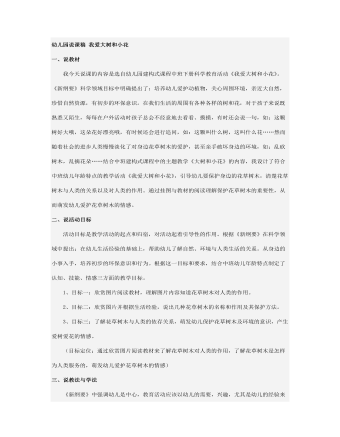
幼儿园说课稿 我爱大树和小花
我今天说课的内容是选自幼儿园建构式课程中班下册科学教育活动《我爱大树和小花》。《新纲要》科学领域目标中明确提出了:培养幼儿爱护动植物,关心周围环境,亲近大自然,珍惜自然资源,有初步的环保意识。在我们生活的周围有各种各样的树和花,对于孩子来说既熟悉又陌生,每每在户外活动时孩子总会不经意地去看看、摸摸,有时还会说一句,如:这颗树好大哦,这朵花好漂亮哦,有时候还会进行追问,如:这颗叫什么树,这叫什么花……然而随着社会的进步人类慢慢淡化了对身边花草树木的爱护,甚至亲手破坏身边的环境,如:乱砍树木,乱摘花朵……结合中班建构式课程中的主题教学《大树和小花》的内容,我设计了符合中班幼儿年龄特点的教学活动《我爱大树和小花》,引导幼儿要保护身边的花草树木,清楚花草树木与人类的关系以及对人类的作用。通过挂图与教材的阅读理解保护花草树木的重要性,从而萌发幼儿爱护花草树木的情感。
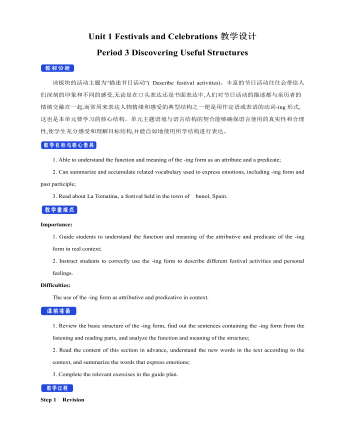
新人教版高中英语必修3Unit 1 Festivals and Celebrations教学设计二
1. Ss look at the picture and scan the passage to understand the main idea while teacher is giving the following questions to inspire Ss to think.*Where are those people?*What are they doing?*Why are they so excited?2. Ss complete the passage with the appropriate -ing form. Then discuss and check the answers with class.Answers: boring, interesting, taking, exciting, amazing3. The teacher raises questions for the students to discuss and encourages them to express their opinions.*Do you like La Tomatina? Why or why not?4. Each group representative reports the discussion result, the teacher gives feedback and the evaluation.Step 6 PracticeActivity 41. Ss complete the Ex 2 in Using structures.2. Check the answers after finishing the exercises.①The dragon boat races are the most exciting part of the Dragon Boat Festival.② The children were excited to go Easter egg hunting.③What an amazing performance! This is the best music festival I have ever been to.④We were amazed by her funny-looking hat.⑤His inspiring speech at the conference won the admiration/ favour of the audience.⑥This is a challenging game to test your memory and observation capabilities. 3. T asks Ss to finish Ex 3 and 4 in Using structures by themselves, then check the answers with class.Step 6 Homework1. Understand and master the functions and usage of the -ing form;2. Finish the other exercises in Using structures.1、通过本节内容学习,学生是否理解和掌握动词-ing形式作定语和表语的功能和意义;2、通过本节内容学习,学生能否在理解文段内容的基础上,根据上下文语境和表达逻辑,能正确运用动词-ing形式描述节日庆典。3、通过本节内容学习,学生是否归纳和积累用于表达情绪的相关词汇。
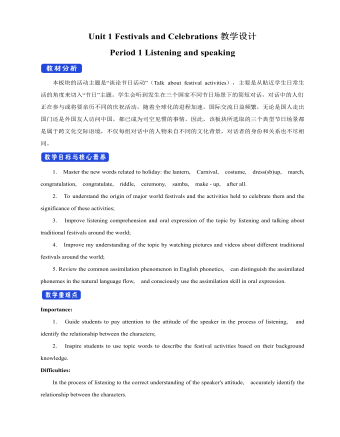
新人教版高中英语必修3Unit 1 Festivals and Celebrations教学设计一
本板块的活动主题是“谈论节日活动”(Talk about festival activities),主要是从贴近学生日常生活的角度来切入“节日”主题。学生会听到发生在三个国家不同节日场景下的简短对话,对话中的人们正在参与或将要亲历不同的庆祝活动。随着全球化的进程加速,国际交流日益频繁,无论是国人走出国门还是外国友人访问中国,都已成为司空见惯的事情。因此,该板块所选取的三个典型节日场景都是属于跨文化交际语境,不仅每组对话中的人物来自不同的文化背景,对话者的身份和关系也不尽相同。1. Master the new words related to holiday: the lantern, Carnival, costume, dress(sb)up, march, congratulation, congratulate, riddle, ceremony, samba, make - up, after all. 2. To understand the origin of major world festivals and the activities held to celebrate them and the significance of these activities;3. Improve listening comprehension and oral expression of the topic by listening and talking about traditional festivals around the world;4. Improve my understanding of the topic by watching pictures and videos about different traditional festivals around the world;5. Review the common assimilation phenomenon in English phonetics, can distinguish the assimilated phonemes in the natural language flow, and consciously use the assimilation skill in oral expression. Importance:1. Guide students to pay attention to the attitude of the speaker in the process of listening, and identify the relationship between the characters;2. Inspire students to use topic words to describe the festival activities based on their background knowledge. Difficulties:In the process of listening to the correct understanding of the speaker's attitude, accurately identify the relationship between the characters.

新人教版高中英语必修3Unit 2 Morals and Virtues教学设计二
Activity 41. Students complete the task of activity 4, then teachers and students check the answers. 2. The teacher organized the students to work together and asked them to use the tables and mind maps sorted out before to retold the important choices in Lin Qiaozhi's life and their resultsStep 5 Language points1. The teacher asks the students to read the text carefully, find out the core words and long and difficult sentences in the text and draw lines, understand the use of vocabulary, and analyze the structure of long and difficult sentences. 2. The teacher explains and summarizes the usage of core vocabulary and asks the students to take notes. 3. The teacher analyzes and explains the long and difficult sentences that the students don't understand, so that the students can understand them better. Step 6 Homework1. Read the text again, in-depth understanding of the text; 2. Master the use of core vocabulary and understand the long and difficult sentences. 3. Complete relevant exercises in the guide plan. 1、通过本节内容学习,学生是否理解和掌握阅读文本中的新词汇的意义与用法;2、通过本节内容学习,学生能否结合文本特点总结林巧稚的人生原则和人格品质特征;3、通过本节内容学习,学生能否针对人生抉择发表自己的看法;能否全面地、客观地、理性地看待问题,进而对道德和人性有更加深入的思考和理解。
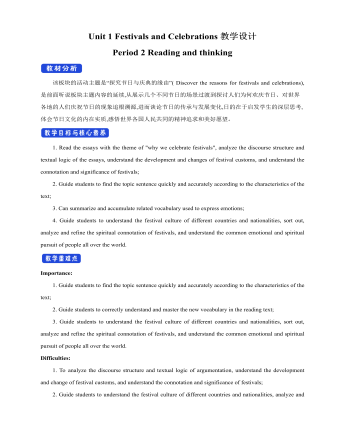
新人教版高中英语必修3Unit 1 Festivals and Celebrations教学设计三
*wide range of origins(= a great number of different origins, many kinds of origins)*It featured a parade and a great feast with music, dancing, and sports. (=A parade and a great feast with music, dancing, and sports were included as important parts of the Egyptian harvest festival.)*.. some traditions may fade away and others may be established.(= Some traditions may disappear gradually, while other new traditions may come into being.)Step 6 Practice(1) Listen and follow the tape.The teacher may remind the students to pay attention to the meaning and usage of the black words in the context, so as to prepare for the completion of the blanks in activity 5 and vocabulary exercises in the exercise book.(2) Students complete the text of activity 5 by themselves.The teacher needs to remind the students to fill in the blanks with the correct form of the vocabulary they have learned in the text.Students exchange their answers with their partners, and then teachers and students check their answers.(3)Finish the Ex in Activity 5 of students’ book.Step 7 Homework1. Read the text again, in-depth understanding of the text;2. Discuss the origin of festivals, the historical changes of related customs, the influence of commercial society on festivals and the connotation and essential meaning of festivals.3. Complete relevant exercises in the guide plan.1、通过本节内容学习,学生是否理解和掌握阅读文本中的新词汇的意义与用法;2、通过本节内容学习,学生能否结合文本特点快速而准确地找到主题句;3、通过本节内容学习,学生能否理清论说文的语篇结构和文本逻辑,了解节日风俗发展与变迁,感悟节日的内涵与意义。

新人教版高中英语必修3Unit 2 Morals and Virtues教学设计三
The joke set her crying.这个玩笑使她哭起来。Step 5 ReadingActivity 31. Students read the small text in activity 3. The teacher provides several small questions to check whether students understand the content of the text and the ideographic function of the -ing form in the text.*Where are those people?*Why did Dr Bethune come to China?*How did he help the Chinese people during the war?*What did Chairman Mao Zedong say about him?2. Ss try to rewrite some sentences using the -ing form. Then check the answers. When checking the answers, the teacher can ask different students to read the rewritten sentences and give comments.Answers:1. he became very interested in medicine, deciding to become a doctor.2. …after hearing that many people were dying in the war.3. Helping to organise hospitals, he taught doctors and nurses, and showed people how to give first aid./ He helped to organise hospitals, teaching doctors and nurses, and showing people how to give first aid.4. …praising Dr Bethune as a hero to be remembered in China.Step 6 PracticeActivity 4Students complete grammar activities 2 and 3 on page 69 of the workbook.Step 6 Homework1. Understand and master the functions and usage of the -ing form;2. Finish the other exercises in Using structures.1、通过本节内容学习,学生是否理解和掌握动词-ing形式作宾语补足语语和状语语的功能和意义;2、通过本节内容学习,学生能否正确使用动词-ing形式描述人物的行为、动作及其经历;3、通过本节内容学习,学生能否独立完成练习册和导学案中的相关练习。

新人教版高中英语必修3Unit 2 Morals and Virtues教学设计四
3.Teachers ask different groups to report the answers to the questions and ask them to try different sentence patterns.The teacher added some sentence patterns for students to refer to when writing.Step 4 Writing taskActivity 51.Write the first draft.Students first review the evaluation criteria in activity 5, and then independently complete the draft according to the outline of activity 4, the answers to the questions listed in the group discussion and report, and the reference sentence pattern.2.Change partners.The teacher guides the students to evaluate their partner's composition according to the checklist of activity 5 and proposes Suggestions for modification.3.Finalize the draft.Based on the peer evaluation, students revise their own compositions and determine the final draft.Finally, through group recommendation, the teacher selects excellent compositions for projection display or reading aloud in class, and gives comments and Suggestions.Step 5 Showing writingActivity 5T call some Ss to share their writing.Step 6 Homework1. Read the passage in this section to better understand the passage.2. Carefully understand the hierarchical structure of the article, and deeply understand the plot of the story according to the causes, process and results;3. Independently complete the relevant exercises in the guide plan.1、通过本节内容学习,学生是否理解和掌握阅读文本中的新词汇的意义与用法;2、通过本节内容学习,学生能否通过人物言行的对比分析道德故事的深层内涵;3、通过本节内容学习,学生能否根据故事的起因、经过和结果来深入理解故事的情节,从而了解文章的层次结构;4、结合现实生活案例发表自己的见解和看法,写一篇观点明确、层次分明的故事评论。

新人教版高中英语必修3Unit 2 Morals and virtues教学设计一
(2) students are divided into groups according to the requirements of activity 3. Each student shares a story of personal experience or hearing-witnessing kindness, and then selects the most touching story in the group and shares it with the whole class. Before the students share the story, the teacher can instruct them to use the words and sentence patterns in the box to express. For example, the words in the box can be classified:Time order: first of all, then, after that, later, finally logical relationship :so, however, although, butTeachers can also appropriately add some transitional language to enrich students' expression:Afterwards, afterwards, at last, in the end, eventuallySpatial order: next to, far from, on the left, in front ofOtherwise, nevertheless, as a result, therefore, furthermore, in addition, as well asSummary: in a word, in short, on the whole, to sum up, in briefStep 8 Homework1. Understand the definition of "moral dilemma" and establish a correct moral view;2. Accumulate vocabulary about attitudes and emotions in listening texts and use them to express your own views;3. Complete relevant exercises in the guide plan.1、通过本节内容学习,学生能否理解理解“道德困境”的定义;2、通过本节内容学习,学生能否通过说话人所表达的内容、说话的语气、语调等来判断其态度和情绪;3、通过本节内容学习,学生能否针对具体的道德困境发表自己的看法和见解,能否掌握听力理训练中的听力策略。

新人教版高中英语必修3Unit 3 Diverse Cultures教学设计三
The price is the same as(the price was)before the war.价格与战前相同。(4)定语从句中的“关系代词+助动词be”可以省略。The ticket(that/which was)booked by his sister has been sent to him.他妹妹订的那张票已送到了他那里。Step 5 PracticeActivity 3(1) Guide students to complete the four activities in the Using Structures part of exercise book, in which activities 1 and 2 focus on ellipsis in dialogue answers, activity 3 focus on signs and headlines, two typical situations where ellipsis is used, and activity 4 focus on ellipsis in diary, an informal style.(2) Combine the examples in the above activities, ask students to summarize the omitted situations in groups, and make their own summary into a poster, and post it on the class wall after class to share with the class.(This step should give full play to the subjectivity of students, and teachers should encourage students to conclude different ellipsis phenomena according to their own understanding, they can conclude according to the different parts omitted in the sentence.)Step 6 Homework1. Understand and master the usages of ellipsis;2. Finish the other exercises in Using structures of Workbook.1、通过本节内容学习,学生是否理解和掌握省略的用法;2、通过本节内容学习,学生能否根据上下文语境或情景恢复句子中省略的成分,体会使用省略的效果;3、通过本节内容学习,学生能否独立完成练习册和导学案中的相关练习。

新人教版高中英语必修3Unit 3 Diverse Cultures教学设计二
(2)Consolidate key vocabulary.Ask the students to complete the exercises of activity 6 by themselves. Then ask them to check the answers with their partners.(The first language:Damage of the 1906 San Francisco earthquake and fire.A second language: Yunnan - one of the most diverse provinces in China).Step 5 Language points1. The teacher asks the students to read the text carefully, find out the more words and long and difficult sentences in the text and draw lines, understand the use of vocabulary, and analyze the structure of long and difficult sentences.2. The teacher explains and summarizes the usage of core vocabulary and asks the students to take notes.3. The teacher analyzes and explains the long and difficult sentences that the students don't understand, so that the students can understand them better.Step 6 Homework1. Read the text again, in-depth understanding of the text;2. Master the use of core vocabulary and understand the long and difficult sentences.3. Complete relevant exercises in the guide plan.1、通过本节内容学习,学生是否理解和掌握阅读文本中的新词汇的意义与用法;2、通过本节内容学习,学生能否结合文本特点了解文章的结构和作者的写作逻辑;3、通过本节内容学习,学生能否了解旧金山的城市风貌、文化特色,以及加利福尼亚州的历史,体会多元文化对美国的影响。

新人教版高中英语必修3Unit 3 Diverse Cultures教学设计四
该板块的活动主题是“介绍一个有显著文化特征的地方”( Describe a place with distinctive cultural identity)。该板块通过介绍中国城继续聚焦中国文化。本单元主题图呈现的是旧金山中国城的典型景象, Reading and Thinking部分也提到中国城,为该板块作铺垫。介绍中国城的目的主要是体现中国文化与美国多元文化的关系,它是美国多元文化的重要组成部分。中国城也是海外华人的精神家园和传播中国文化的重要窗口,外国人在中国城能近距离体验中国文化。1. Read the text to understand the cultural characteristics of Chinatown in San Francisco and the relationship between Chinese culture and American multiculturalism;2. Through reading, learn to comb the main information of the article, understand the author's writing purpose and writing characteristics;3. Learn to give a comprehensive, accurate, and organized description of the city or town you live in;Learn to revise and evaluate your writing.Importance:1. Guide the students to read the introduction of Chinatown in San Francisco and grasp its writing characteristics;2. Guide students to introduce their city or town in a comprehensive, accurate and organized way;3. Learn to comb the main information of the article, understand the author's writing purpose, and master the core vocabulary.